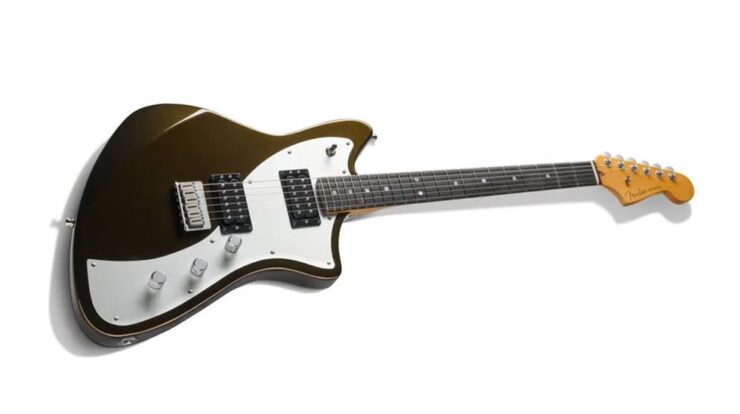
This post was originally published on this site

When Fender debuted the Meteora body shape in 2018 (as the Parallel Universe Meteora), I was among those who immediately thought it looked like a pretty worthy addition to the company’s venerated line of “offset” guitars. Taken in hand, though, the guitar may have struck some as having a bit of an identity crisis—which may account for the changes we see in the third iteration, the new American Ultra II.
All Metoras feature an intriguing blend of classic Fender elements (Strat-style headstock, Jazzmaster/Jaguar-esque outline) and in the case of the Player Plus Meteora HH and the American Ultra II, more Gibson-like appointments (humbuckers and 3-way selector). But whereas the Telecaster-like Parallel Universe model and Player Plus HH leaned a little more retro, the American Ultra II both tilts more modern and fine-tunes some of the original’s tonal quirks and limitations.
Diverging Contours
Available in three finishes (here we’ve got Texas Tea), the latest Meteora has exposed-coil Haymaker humbuckers and matching pickup rings that, alongside the anodized aluminum pickguards and knurled metal knobs, lend a more hard rock/metal aesthetic than the original Meteora’s WideRange-styled pickups and brighter finish options. (The new avalanche and ultraburst finishes in particular, with their white and crème pickups, respectively, are reminiscent of ’70s and ’80s DiMarzio-outfitted rock machines.) Having demoed the Player Plus Meteora HH in PG’s First Look video, I’ll admit I prefer that series’ looks. But there’s no arguing that both fundamental tones and the myriad permutations proffered by the American Ultra II’s unusual tone-control array feel much more useful and well thought out this time around.
Wait, “unusual?” If you’ve googled this guitar, chances are you’ve seen the same conflicting information I found. Some sites say it has two tone controls, others (including the manufacturer’s at publication time) list a master volume, a master tone, and a bass-contour knob. Upon plugging in and twiddling knobs, though, I was immediately confused and, honestly, initially not very impressed. So I looked through the case, found the manual, and finally came to the truth: The Meteora is actually devoid of traditional tone controls, using instead a master volume, a bass-contour knob (nearest the output jack), anda treble-contour knob (middle). This setup was a first for me. Also, unlike the Jaguar, the alder-bodied Meteora has a standard Fender-scale 25.5″ maple neck, with an ebony fretboard and employs the company’s “modern D” profile. There’s a Graph Tech TUSQ nut, too, and sealed locking tuners.
More Offset Than Meets the Eye
I tested the American Ultra II with an EL34-powered Jaguar HC50 (with a ceramic-magnet Weber Gray Wolf), a ’76 Fender Vibrolux Reverb (with alnico Celestion G10 Golds), a KT66-driven Sound City SC30, and a bunch of drive, fuzz, delay, and reverb pedals. Through the two latter amps combined, the Meteora II’s contour controls proved most powerful, yielding a pretty astonishing array of sounds—particularly with fuzz pedals. With the traditional control scheme on my favorite offset (and main band guitar, a Jaguar with Curtis Novak JAG-V pickups), I primarily use the lead circuit’s tone knob (or the rhythm circuit) to tame fuzz pedals—and I find that setup more versatile than a lot of other guitars. But the Meteora’s contour knobs take things much further, letting you effectively revoice filth pedals in ways otherwise only possible with an adjacent EQ pedal.
With both contours full up, the Haymaker pickups still lean brighter than some dual-’bucker fans might prefer—but not as strident as the Player Plus units. And the bass contour is especially helpful for warming/toughing up the bridge unit, as well as cleaning up low-mid clutter you might encounter with the neck pickup soloed and dimed. With a clean-ish tone and both pickups engaged, dialing volume and both contours back a bit yields wiry, muscular funk tones. Boost the volume back up a bit and hit the S-1 coil tap, and you get leaner funk tones very much in the Strat realm. In all, the variety of sounds possible with this control scheme is almost revelatory. So much so that it’s a wonder more guitars don’t go this route—because you’re no longer limited to just darkening or lightening a pickup with a single knob. The crossover EQ points between the two controls are well-tuned to complement each other and open up possibilities you simply couldn’t get with standard tone controls. And the treble-bleed circuit assures that volume adjustments don’t muddy things up.
The Verdict
Whether the tweaks to the American Ultra II Meteora alleviate its somewhat vague positioning is up for debate. Fender offset fans tend to fall in either the traditionalist/vintage camp or the more modern “I like the shape but not the weird switches and hardware” camp. And, to most eyes, the Ultra II probably looks pretty modern despite the vintage neck and headstock tint. But tonally, even though the control scheme looks straightforward, the array of available tones is far more akin to the versatility afforded by Jaguar and Jazzmaster circuits than, say, a modern rock guitar. It is a bit of a bummer that the Ultra costs twice as much as the Player Plus HH (albeit with hardshell case) but has no vibrato option. Considering its sheer tonal quality and versatility, the latest Meteora absolutely has the edge over its predecessor—but I’d love to see future versions fully embrace their offset-ness with a vibrato system befitting the Meteora’s sonic forebears.







